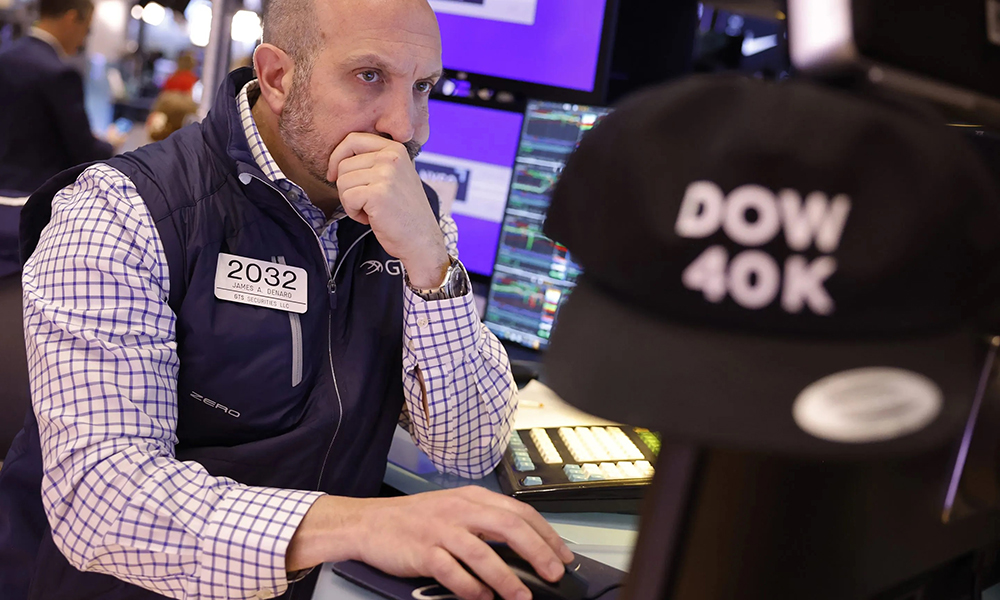
在经过表现出色的2023年之后,今年美国股市依旧没有受到恶性通胀和高利率的影响。从年初至今,标普500指数上涨超过12%,创下历史新高,在不到六个月的时间里,就超过了该蓝筹股指数自1957年以来约10%的平均年度涨幅。强劲的第一季度财报季和有韧性的美国经济,为股市的成功创造了条件,但华尔街的一些顶级策略师仍担心经济下滑即将来临。
Stifel首席股票策略师巴里·班尼斯特在周二的一份报告中表示,他预计到今年夏末,标普500指数将下挫约10%,跌至4,750点。这位华尔街资深策略师曾在2023年认为,如果按通胀率调整,股市回报可能在十年内持平。他解释了自己持悲观立场的三个主要原因。
首先是“顽固的”通胀,这或许并不意外。班尼斯特数月来一直警告称,他认为在2023年第二季度结束的长达五个季度的“伪衰退”期间,美联储已经“收获”了所有通货紧缩,而通货紧缩通常伴随着经济衰退。今年5月,他甚至认为,这意味着美联储官员将通胀率恢复到2%的目标只是“白日梦”。
班尼斯特担心,服务业支出强劲,加上医疗保健、金融和保险成本上涨,将导致这一关键经济部门持续通胀。他表示,如果再加上超出先前预期的房价上涨、生产率增速放缓以及工资持续增长,那么就会出现“适度的滞胀”。
这位策略师警告称,这种低增长、适度通胀的前景可能会将标普500指数的市盈率(用于评估该指数价值的指标)降低500点,因为投资者会将较低的潜在收入增长和较高的成本考虑在内。
据《华尔街日报》报道,今年股市大涨后,标普500指数的市盈率略高于23倍。这远高于19.4倍的历史平均市盈率。
在最近的股市上涨之后,并非只有班尼斯特在敲响警钟。富国银行(Wells Fargo)的策略大师斯科特·沃伦在周三的报告中告诉投资者“准备迎接更大的股市波动”。这位资深全球市场策略师写道:“未来几个月,许多潜在问题可能会引发金融市场波动。”
与班尼斯特一样,沃伦也将美联储的降息时机视为市场回调的潜在触发因素。沃伦认为,美联储的经济学家们在3月份预测今年将有三次降息,而在6月份的联邦开放市场委员会(FOMC)会议上,他们很可能只预测一到两次降息。这可能会给股市带来问题,因为许多投资者仍然预计今年会有多次(通常是)刺激市场的降息。
沃伦写道:“‘五月卖股别回头’这句古老的市场箴言今年会奏效吗?这还有待观察,但我们预计[标普500指数]在年底前不会有太大幅度的上涨。”
这位富国银行策略师还警告称,食品和能源价格高企将继续打压消费者情绪,美国大选也可能带来市场波动。他建议投资者关注工业、材料、能源和医疗保健等行业内规模较大的所谓“优质”公司,即资产负债表强劲、负债率低、盈利能力稳健的公司,这些公司不属于估值较高的科技领域。
同样,Stifel的班尼斯特建议持有所谓“防御性价值股行业”的“优质”股票,这些行业通常比较稳定,包括医疗保健、必需消费品和公用事业行业等。
虽然这两位策略师都认为市场未来可能会经历阵痛,但也不全是坏消息。富国银行的沃伦在总结时使用的几句至理名言,值得每一位投资者时刻牢记:“如果我们有眼光,股市下行会带来投资机会。做好准备。制定计划。保持谨慎。”(财富中文网)
翻译:刘进龙
审校:汪皓
在经过表现出色的2023年之后,今年美国股市依旧没有受到恶性通胀和高利率的影响。从年初至今,标普500指数上涨超过12%,创下历史新高,在不到六个月的时间里,就超过了该蓝筹股指数自1957年以来约10%的平均年度涨幅。强劲的第一季度财报季和有韧性的美国经济,为股市的成功创造了条件,但华尔街的一些顶级策略师仍担心经济下滑即将来临。
Stifel首席股票策略师巴里·班尼斯特在周二的一份报告中表示,他预计到今年夏末,标普500指数将下挫约10%,跌至4,750点。这位华尔街资深策略师曾在2023年认为,如果按通胀率调整,股市回报可能在十年内持平。他解释了自己持悲观立场的三个主要原因。
首先是“顽固的”通胀,这或许并不意外。班尼斯特数月来一直警告称,他认为在2023年第二季度结束的长达五个季度的“伪衰退”期间,美联储已经“收获”了所有通货紧缩,而通货紧缩通常伴随着经济衰退。今年5月,他甚至认为,这意味着美联储官员将通胀率恢复到2%的目标只是“白日梦”。
班尼斯特担心,服务业支出强劲,加上医疗保健、金融和保险成本上涨,将导致这一关键经济部门持续通胀。他表示,如果再加上超出先前预期的房价上涨、生产率增速放缓以及工资持续增长,那么就会出现“适度的滞胀”。
这位策略师警告称,这种低增长、适度通胀的前景可能会将标普500指数的市盈率(用于评估该指数价值的指标)降低500点,因为投资者会将较低的潜在收入增长和较高的成本考虑在内。
据《华尔街日报》报道,今年股市大涨后,标普500指数的市盈率略高于23倍。这远高于19.4倍的历史平均市盈率。
在最近的股市上涨之后,并非只有班尼斯特在敲响警钟。富国银行(Wells Fargo)的策略大师斯科特·沃伦在周三的报告中告诉投资者“准备迎接更大的股市波动”。这位资深全球市场策略师写道:“未来几个月,许多潜在问题可能会引发金融市场波动。”
与班尼斯特一样,沃伦也将美联储的降息时机视为市场回调的潜在触发因素。沃伦认为,美联储的经济学家们在3月份预测今年将有三次降息,而在6月份的联邦开放市场委员会(FOMC)会议上,他们很可能只预测一到两次降息。这可能会给股市带来问题,因为许多投资者仍然预计今年会有多次(通常是)刺激市场的降息。
沃伦写道:“‘五月卖股别回头’这句古老的市场箴言今年会奏效吗?这还有待观察,但我们预计[标普500指数]在年底前不会有太大幅度的上涨。”
这位富国银行策略师还警告称,食品和能源价格高企将继续打压消费者情绪,美国大选也可能带来市场波动。他建议投资者关注工业、材料、能源和医疗保健等行业内规模较大的所谓“优质”公司,即资产负债表强劲、负债率低、盈利能力稳健的公司,这些公司不属于估值较高的科技领域。
同样,Stifel的班尼斯特建议持有所谓“防御性价值股行业”的“优质”股票,这些行业通常比较稳定,包括医疗保健、必需消费品和公用事业行业等。
虽然这两位策略师都认为市场未来可能会经历阵痛,但也不全是坏消息。富国银行的沃伦在总结时使用的几句至理名言,值得每一位投资者时刻牢记:“如果我们有眼光,股市下行会带来投资机会。做好准备。制定计划。保持谨慎。”(财富中文网)
翻译:刘进龙
审校:汪皓
After a stellar 2023, the stock market has continued to brush off the impact of stubborn inflation and higher interest rates this year. The S&P 500 is up more than 12% year to date to a record high, topping the roughly 10% average annual rise in the blue-chip index since 1957 in under six months. A strong first-quarter earnings season and a resilient economy have underpinned stocks’ success, but some of Wall Street’s top strategists still fear a downturn is on the way.
In a Tuesday note, Stifel’s chief equity strategist Barry Bannister said he expects the S&P 500 to sink roughly 10% to 4,750 by the end of the summer. The Wall Street veteran—who argued in 2023 that the stock market returns could be flat for a decade, when adjusted for inflation—cited three main reasons for his bearish outlook.
The first, perhaps unsurprisingly, was “sticky” inflation. Bannister has warned for months now that he believes the Federal Reserve already “harvested” all the disinflation that typically comes with a recession during a five-quarter-long “pseudo-recession” that ended in the second quarter of 2023. In May, he even argued that this means Fed officials’ goal to return inflation to 2% is nothing but a “pipe dream.”
Bannister fears strong services spending along with rising health care, financial, and insurance costs will lead to persistent inflation in that key sector of the economy. Tack on more housing inflation than previously forecast, a slowing productivity growth rate, and persistent wage growth and you have a recipe for a “moderate form of stagflation,” he says.
This low-growth, moderate-inflation outlook could cut the S&P 500’s price-to-earnings ratio—a metric used to value the index—by 500 points, the strategist warned, as investors account for lower potential revenue growth and higher costs.
After stocks’ surge this year, the S&P 500 trades at just over 23 times earnings, according to the Wall Street Journal. That’s rich compared to the historical average of 19.4 times earnings.
Bannister isn’t the only one sounding the alarm after the stock market’s recent rise. Wells Fargo’s strategy guru Scott Wren told investors to “buckle up for more volatility” in his Wednesday note. “There are a number of potential issues that could spark financial-market volatility in the months ahead,” the senior global market strategist wrote.
Wren, like Bannister, cited the timing of the Fed’s interest-rate cuts as a potential trigger for a market pullback. After projecting three interest rate cuts this year back in March, the Fed’s economists are likely to pencil in only one or two cuts at June’s Federal Open Market Committee (FOMC) meeting, according to Wren. That could spark issues for stocks, as many investors are still expecting multiple (typically) market-juicing rate cuts this year.
“Will the old market bromide ‘sell in May and go away’ work this year? That remains to be seen, but we are not expecting the [S&P 500] to gain meaningful upside here through year-end,” Wren wrote.
The Wells Fargo strategist also warned that high food and energy prices will continue to weigh on consumer sentiment, and the U.S. election is likely to bring volatility to markets. He recommended investors look to larger, so-called “quality” companies—those with strong balance sheets, low debt, and solid profitability—in sectors like industrials, materials, energy, and health care that are outside the highly valued tech space.
Similarly, Stifel’s Bannister recommended sticking with “quality” stocks in so-called “defensive value equity industries” that are often more stable, including the health care, consumer staples, and utilities sectors.
While both of these strategists see potential pain ahead for markets, it’s not all bad news. Wells Fargo’s Wren concluded with a few words of wisdom that every investor needs to be reminded of from time to time: “Equity downside, should we see it, can offer opportunities. Be ready. Have a plan. Buckle up.”






